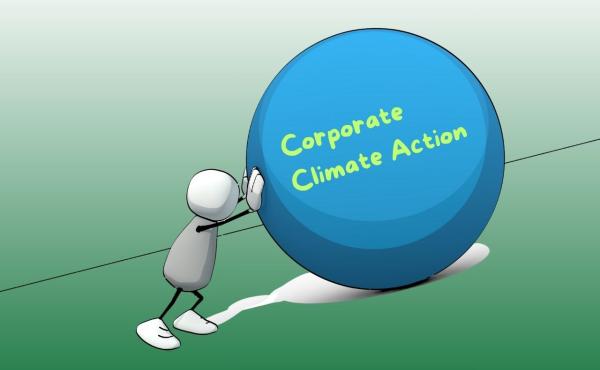
The ECGI blog is kindly supported by

Does sustainable investing work? (Part 2) Launch and reaching the earth’s lower atmosphere
In the first article in this brief series, we introduced the three-stage rocket analogy to better understand the degree to which Sustainable Investing (“SI”) practices can have positive real-world impact through investment activity.
This is because, just like with a three-stage rocket, most SI practices are intended to trigger a three-stage process, all of which need to be completed for the SI intervention to be considered successful:
- The activity that the investor undertakes must have some effect on the companies (or the managers of those companies) in which they invest, which (at least in principle) can trigger a change in what the company does.
- Managers at the company must indeed respond to that effect and change their actions. This in turn changes what the company does and creates an impact in the real economy that would not have happened without the investor activity.
- The impact in the real economy must persist even after second order impacts and must not be (entirely) unwound by the response of competitors and consumers to the company’s actions.
We’ve also reviewed around 60 relevant papers that discuss efficacy of SI practices, in order to determine which practices can have which effects, and whether there is any evidence of these direct, indirect and systemic effects. The overview of these publications can be found here.
In this second article, we draw some conclusions on stage 1 and stage 2 effects for two commonly adopted SI strategies:
- Capital allocation (including divestment and tilting)
- Engagement (including collaborative engagement and activism)
While not claiming to be exhaustive, based on the reviewed publications, there seems to be a fair bit of evidence that these strategies have stage 1 effects. Differential capital allocation by sustainable investors can influence share prices and cost of capital. Engagement practices, self-evidently, result in signals being sent to companies about investor preferences. There is some evidence of stage 2 effects also. For engagement in particular there is clear evidence of companies taking action as a consequence of investor engagement. The evidence is less clear, and more contested, relating to capital allocation, although some stage 2 impacts are claimed by some papers.
While this appears to be good news, we discuss some caveats before summarizing our conclusions.
Capital allocation – evidence of stage 1 and stage 2 effects
While it is agreed that in theory capital allocation decisions by investors can affect cost of capital, the causality is not always clear in specific cases. Cost of equity is hard to measure: it is fiendishly difficult to unpick expected from realized returns. For example, sustainable stocks may show higher realized returns on their way to being rerated to a lower expected cost of capital at which point, being less risky, they might underperform less sustainable stocks. Or high carbon emitters may show higher realized returns as a result of outperforming earnings expectations as governments fail to implement robust climate regulation. It is also difficult to disentangle effects produced by capital allocation from risk-based explanations. For example, sin stocks have higher realized returns, but it’s not always clear that this is caused by investors divesting them as opposed to their exposure to standard factors known to be drivers of stock price returns. Environmentally problematic firms may have a higher cost of debt due to some investors shunning them or because of a risk-based explanation. This remains a highly contested area, although it is fair to say that, on balance, overall there is evidence for cost of capital impacts from capital allocation by sustainable investors.
But even if there is a stage 1 impact, what about stage 2? It appears managers do not closely track changes in cost of capital and/or the changes may be relatively small; in other words, a change in cost of capital may not provide management with a strong incentive to change the company’s activities or behavior – because where these changes are observable they tend to be rather small. Even worse, in certain cases the cost of capital impact may be counterproductive. Increasing the cost of capital for brown firms may cause them to cut back on green investments and double down on brown activity. Reducing cost of capital for green firms is unlikely to make them more green, and will only help them grow if they are already capital-constrained.
Capital allocation and flows from sustainable investors can affect share prices. In theory this can create incentives for managers to respond, because they will want to protect their share price given they have stock-based compensation. But in practice these effects are hard to identify. Managers need a clear route of action to avoid, say, divestment (but an oil company is unlikely to stop being an oil company). Also, the cost of that action must be such that the benefit of attracting sustainable investors outweighs the drag on profits and share price that the action itself causes.
Overall, although the area is contested, we conclude there is reasonable evidence of stage 1 impacts for capital allocation, but stage 2 is much harder to pin down.
Engagement
Engagement is the one SI practice whose efficacy in bringing about stage 1 and stage 2 effects is well evidenced. A number of studies document correlations, and plausible causality, linking engagement on environmental and social issues with changes in company actions and, in some cases, outcomes, such as environmental incidents. While some studies show impact from the actions of a single investor, the literature points to the greater efficacy of collaborative engagements. Other studies suggest that engagement success can be enhanced by factors such as the achievability of the engagement ask, the nature of the lead investor, and a credible divestment threat that the company can realistically take action to avoid.
While the case for stage 1 and stage 2 impacts is stronger for engagement than for capital allocation, there are significant questions about the scale and additionality of that impact.
Scale of impact
Even to the extent that capital allocation and engagement have stage 1 and stage 2 impact, there are questions as to the scale of that impact, when set against the sustainability challenges we face today.
Much academic research focuses on whether the impact of a SI practice is statistically significant. This means that there is a very high chance that the effect is not zero. However, what matters for real-world action on sustainability challenges is the size of the impact. We observe that, when we take the time to analyze the regression tables that are the staple of academic papers, often if there is a statistically significant stage 1 effect, it tends to be fairly insignificant economically. For example, a change of even 100 basis points in the cost of capital for a given company is unlikely to be acted upon, or perhaps even noticed. A frequently heard reaction to this is that, “yes, effects are small today, but once the whole market does it…” We want to caution against what we believe is likely wishful thinking. Estimates of the type of scale that would be needed for effects to become meaningful economically (in the order of a few percent change in cost of capital, which might be necessary to be equivalent to, say, a carbon tax of any meaningful scale) are often 50%+ of total financial markets engaging in (the same) SI practices, whereas today it is a fraction of this. We should manage our expectations as to the likelihood that we will ever reach those high numbers – especially if the SI practices needed for this are difficult to deploy and come with potentially negative financial side effects for companies or investors.
Turning to engagement, the concern is less about success rates of engagement, which for collaborative engagements some studies show to be 50% or more. Rather it is about what is achieved through that engagement. Often the successes achieved are where the changes asked of management are low cost or already planned (i.e. “low hanging fruit”). Looking into the details, many “actions” arising from engagement are in fact simply disclosures about existing activities or policies & promises – i.e. the commitments companies make, or targets they set. While this is understandable, it should be noted that creating a policy or adopting a target is a typical “low hanging fruit” option for a company that is engaged by SI investors. Companies know this, and are good at making changes that will show up in ESG ratings, knowing full well that the heavy lifting (if any) can be put off till a later date, sometimes forever. The potentially strategic use of such commitments by companies raises serious questions about whether these engagements are bringing about real-world actions that would not have occurred otherwise and that would result in meaningful change at systemic level.
Finally, a concern about scale of impact arises because a number of studies on engagement identify, and indeed trumpet, the fact that successful engagements are associated with improved shareholder outcomes such as increased share price or lowered risk. While this win-win narrative is seductive, it is also evidence of the insufficiency of the actions that engagement has delivered. Many required system changes – the energy transition required to address climate change being the clearest example – will mean that there will be winners and losers in many industries. To rise to the challenge of systemic risks, investor engagement would need to separate and push portfolio companies into these categories. We are skeptical about the likelihood that investors will persuade companies to become these ‘losers’ – i.e. give up profitable business lines or make investments in businesses that are not (yet) profitable at meaningful scale – even if this would make a difference at a societal level. No matter how large the coalition of investors and how effective their engagement practices, no company will voluntarily render itself uncompetitive or put itself out of business.
Can there be impact? Theory of change and zone of discretion
This is already getting us into stage 3 territory – which we will discuss in the final article – but the research for this project that we have described so far illustrates very clearly that investors should think carefully about the theory of change driving the company change they are seeking.
We see many examples in academic research or in real-life situations where this stage-2 effect, or change in company behavior, is simply assumed to be there but not verified; where it is assumed that the change in company behavior is a meaningful contribution to the desired (stage-3) system change; or where it is assumed that the stage-2 contribution can even be made by the company, and is a contribution that the company is willing and able to deliver in line with the fiduciary duties of the board to promote the success of the company; in other words is in its ‘zone of discretion’.
One paper we reviewed asserted that since an SI practice had resulted in a change in cost of capital, creating an incentive for companies to transform their business, this practice should be considered an effective investor tool to contribute to the energy transition. However, there was no discussion about whether the companies in question would in fact transform, or whether that was the type of transformation that would be needed to drive the energy transition forward. Creating very weak incentives for companies to transform their business and counting this as a stage 3 success is misleading, and having a clear theory of change on the three stages of outcomes can prevent this. We have not explicitly cited the paper we used in this example because it would be unfair to single it out. The extrapolation from Stage 1 to Stage 3 effects is widespread.
Similarly, in the field of impact investing, often investors assume that companies can make contributions to the Sustainable Development Goals (SDGs). However, upon scrutiny, it often turns out the contributions the companies can make have little or nothing to do with solutions needed to actually reach the SDGs. For example, pharmaceutical companies are often assumed to be an “SDG 3 (health) investment”. Yet SDG 3 requires action on issues such as access to health for the poor, that few profit-seeking pharmaceutical companies feel able to contribute to. To claim a contribution to a stage-3 effect (access to health), the investor should ensure the action is within a company’s ‘zone of discretion’ – is the company willing and able to develop or expand the desired access to health activities in poor countries and would directors view that as consistent with their fiduciary duties?
In sum, investors who adopt SI practices with a view to reaching stage-3 effects should ensure that there is solid evidence that all three stages of the rocket can – at least in theory – be achieved. If there is already a break-down in the theoretical chain of causality, of course it can never work in practice either.
Conclusions
In short, the conclusions we have reached regarding stage 1 and 2 effects do not provide a lot of reason for optimism that sustainable investing practices will make anything other than a marginal contribution to the major societal challenges we face today.
Overall there is reasonable evidence that the common SI techniques of capital allocation and engagement can achieve Stage 1 effects. But the evidence for Stage 2 effects, and in particular economically significant real-world Stage 2 effects, is quite limited, even for engagement.
Looking through to the size of plausible real-world impacts is crucial. Otherwise papers claiming that “divestment affects cost of equity” or “engagement works” can give investors the illusion that they have a broad range of effective instruments at their disposal, whereas in reality those instruments – even if they can have some effect – often achieve exceedingly little in terms of addressing underlying societal problems, which is ostensibly their aim.
To paraphrase Pedro Matos, from his paper ESG and Responsible Institutional Investing Around the World – A Critical Review: “the question ultimately is whether Sustainable Investing is truly helping to achieve societal goals.”[1]
In the final part of our series we will discuss this question, drawing conclusions about the potential systemic effects of SI practices, and offering investors with a firm commitment to Stage 3 effects – real-world impact – recommendations on which practices to pursue.
--------------------
By Harald Walkate and Tom Gosling
Continue reading in this series
Part 1 – Introducing the three stage rocket analogy
ECGI Blog: Call for Views: Does sustainable investing work?
--------------------
The research that these articles are based on was generously funded by Royal London Group. Falko Paetzold at the University of Zurich and Julian Kölbel at the University of St. Gallen have kindly agreed to review drafts of these articles and have provided us with invaluable input.
--------------------
[1] Matos used the term “ESG investing”, but some people view ESG investing as simply taking into account ESG risks and opportunities and so would claim there should be no expectation it should change the world. To avoid this potential confusion, we have therefore substituted our own phrase, Sustainable Investing.
The ECGI does not, consistent with its constitutional purpose, have a view or opinion. If you wish to respond to this article, you can submit a blog article or 'letter to the editor' by clicking here.





